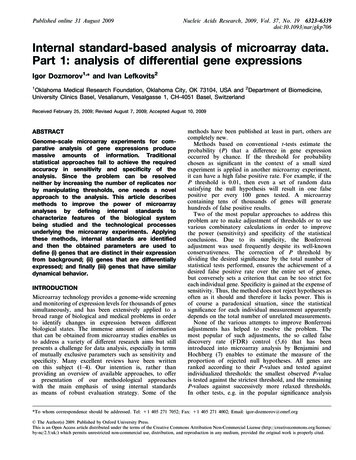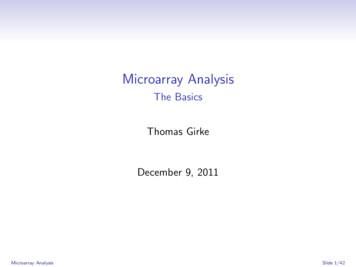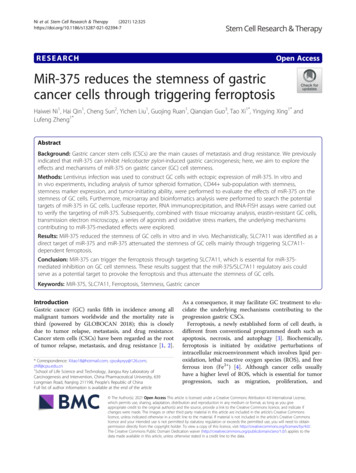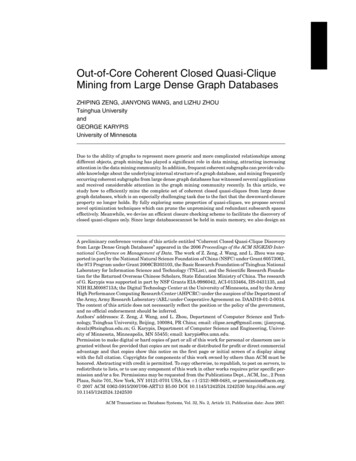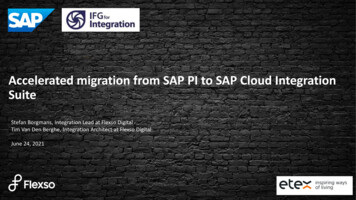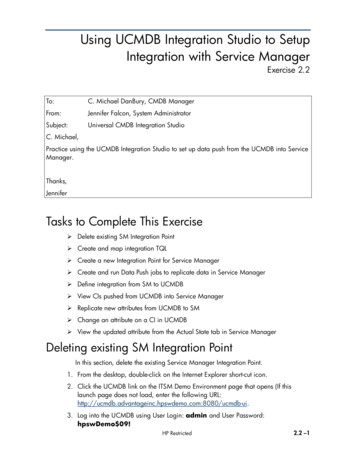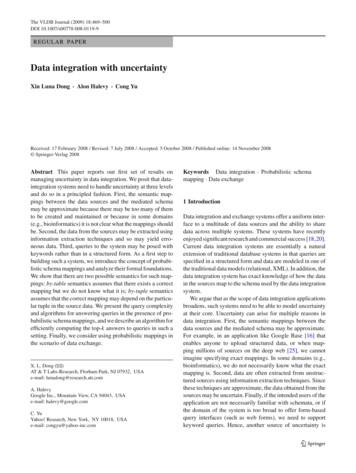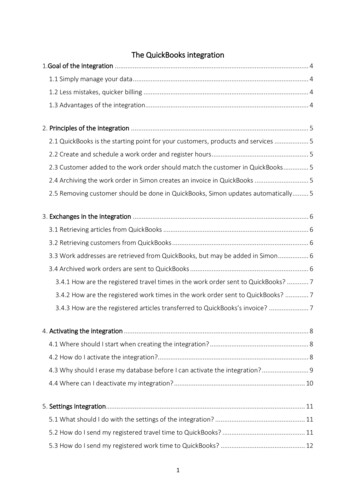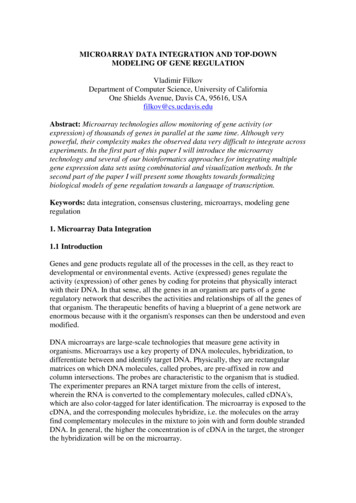
Transcription
MICROARRAY DATA INTEGRATION AND TOP-DOWNMODELING OF GENE REGULATIONVladimir FilkovDepartment of Computer Science, University of CaliforniaOne Shields Avenue, Davis CA, 95616, USAfilkov@cs.ucdavis.eduAbstract: Microarray technologies allow monitoring of gene activity (orexpression) of thousands of genes in parallel at the same time. Although verypowerful, their complexity makes the observed data very difficult to integrate acrossexperiments. In the first part of this paper I will introduce the microarraytechnology and several of our bioinformatics approaches for integrating multiplegene expression data sets using combinatorial and visualization methods. In thesecond part of the paper I will present some thoughts towards formalizingbiological models of gene regulation towards a language of transcription.Keywords: data integration, consensus clustering, microarrays, modeling generegulation1. Microarray Data Integration1.1 IntroductionGenes and gene products regulate all of the processes in the cell, as they react todevelopmental or environmental events. Active (expressed) genes regulate theactivity (expression) of other genes by coding for proteins that physically interactwith their DNA. In that sense, all the genes in an organism are parts of a generegulatory network that describes the activities and relationships of all the genes ofthat organism. The therapeutic benefits of having a blueprint of a gene network areenormous because with it the organism's responses can then be understood and evenmodified.DNA microarrays are large-scale technologies that measure gene activity inorganisms. Microarrays use a key property of DNA molecules, hybridization, todifferentiate between and identify target DNA. Physically, they are rectangularmatrices on which DNA molecules, called probes, are pre-affixed in row andcolumn intersections. The probes are characteristic to the organism that is studied.The experimenter prepares an RNA target mixture from the cells of interest,wherein the RNA is converted to the complementary molecules, called cDNA's,which are also color-tagged for later identification. The microarray is exposed to thecDNA, and the corresponding molecules hybridize, i.e. the molecules on the arrayfind complementary molecules in the mixture to join with and form double strandedDNA. In general, the higher the concentration is of cDNA in the target, the strongerthe hybridization will be on the microarray.
Figure 1: On the left is a diagram of the microarray process from RNA collection to its quantification(picture SUNYSB Microarray facility); on the right is a robotic printing head which is attachingparts of gene molecules to a plate (picture Lawrence Berkeley Lab)The microarray is washed to remove excess molecules, and is color-scanned. Thescan of a microarray is a rectangular grid of (usually) red / green (blue) / black dots.The intensity of the colored dots is proportional to the level of hybridization, whichin turn indicates levels of genetic expression. The process is pictorially described inFig 1. In particular, black indicates the level of expression (concentration oractivity) of unexpressed control molecules, red may indicate expression higher thancontrol, and green may indicate expression lower than control. As a result, withmicroarrays specifically tuned to a particular organism, it is possible to measure thelevel of concentration of any given gene, at any time, relative to a control set ofDNA molecules. The technology responsible for this is a robotic printer, the head ofwhich is shown on the right in Fig. 1, which can attach thousands of spots on fewsquare inches of medium such that two spots next to each other can be verydifferent molecules.With microarrays one can examine the reaction of particular genes (via theirexpression) to environmental conditions, and establish correlation between genesand their function on a cellular level. The power of DNA microarrays, though, liesin their parallelism, since measures of gene expressions are obtained for thousandsof genes at the same time. This experimental breadth in principle makes it possibleto both identify differentially expressed genes across experiments, important whenit is needed to find the markers for diseased vs. healthy cells, and identify genes ofsimilar functionality when the mechanism of action of one but not other gene isknown.As you may imagine, because of their promise, everyone wants to, and does, gettheir hands on this technology. And once they do they start performing lots ofexperiments with it and generating tones of data. And since there are infinitenumbers of ways to setup experiments it is unlikely that this trend will abate in thenear future. Just to illustrate the wealth of data available, the worldwide repositoryfor microarray data, the Stanford Microarray Database, SMD (http://genomewww5.stanford.edu) as of the last week of year 2004 counted more than 50000catalogued microarray experiments over 35 organisms, and almost 1400 users overnearly 280 labs in the world!
Figure 2: Scanned microarray image P. Brown’s lab at Stanford (left), and a spreadsheet snapshot ofa typical microarray data set of hundreds of yeast microarrays (genes are rows, experiments columns)With the exploding volume of microarray experiments comes increasing interest inmining repositories of such data. But meaningfully combining results from variedexperiments on an equal basis is a challenging task. This makes the case for dataintegration. Especially when dealing with large-scale data, integration becomes notjust useful but very necessary.There have been several previous attempts toward general integration of biologicaldata sets in the computational biology community. Marcotte et al.[1], for example,give a combined algorithm for protein function prediction based on microarray andphylogeny data, by classifying the genes of the two different data sets separately,and then combining the gene pairwise information into a single data set. Pavlidis etal.[2] use a Support Vector Machine algorithm on similar data sets to predict genefunctional classification. Both methods need hand tuning with any particular type ofdata both prior and during the integration for best results. Ad hoc approaches to dataintegration are difficult to formulate and justify, and do not readily scale to largenumbers of diverse sources, since different experimental technologies have differenttypes and levels of systematic error. In such an environment, it is not always clearthat the integrated product will be more informative than any independent source.1.2 Data Integration by Consensus ClusteringClustering has shown to be an extremely useful technique for microarray dataanalysis, especially if very little is known about that data a priori (“fishingexpeditions”). That is because genes grouped by their expression profiles often arefunctionally related. (see Fig. 3) There are many different clustering techniques:hierarchical, k-means, topology based, fuzzy methods based, etc. For more onclustering microarray data one can consult for example [4] or my lectures at“http://www.cs.ucdavis.edu/ filkov/classes/289a-W03/l6.pdf”.This is where we came in. Our idea was simply that if clustering is so popular thenpeople use it all the time and they must have clustered the same genes of theirfavorite organism (say yeast, or human) many times over. Intuitively, different
abctimetimeaRNA Processing/Splicing GenesbGlycolysisGenesdFigure 3: Shown on the left are clustered expression profiles of a subset of genes of yeast (shown arehundreds out of the 6000 genes), observed on microarrays at different points in time. The visualclusters actually correspond to functional clusters, as illustrated by the first two groups [3].clusterings of the same genes could be used to tell us more about the groups that thegenes co-belong to than the individual clusterings themselves. So, our goal becameto develop methods based on the various, source-specific, clusterings of the data (orthe meta-data) to both (a) provide an integrated view of the data and (b) eliminatemisclassifications due to errors in the individual data sets. Both of these goals arenaturally addressed by the theoretical problem of consensus clustering, which goalis to find a representative or consensus clustering that describes well a set of givenclusterings.Mathematically, clusterings are just set partitions, and formally, the ConsensusClustering problem (CC) can be written as:CC: Given k set-partitions P1, P2, ,Pk and a distance measure d(.) on them,find a consensus partition C that minimizes S d (P , C)iAs our distance measure we chose the symmetric difference distance, which countspairs of simultaneously co-clustered (or simultaneously not co-clustered) elementsin both clusterings (i.e. partitions). It is possible to show that with this distancemeasure the consensus clustering problem above becomes NP-complete [5], soexact solutions are intractable, especially since our data sets are very big. Instead,we developed several different heuristics for solving CC, and chose the “best” outof them for our system (by best we mean one satisfying some theoretically provablebounds as well as outperforming the other heuristics in our tests). In that heuristicthe space of solutions is traversed by moving between set partitions by simple singleelement swaps between clusters, while deciding whether a move is beneficial basedon a simulated annealing optimizer [5]. The heuristic could handle hundreds ofgenes and hundreds of clusterings (i.e. set partitions) in real time (seconds) andthousands of genes in minutes.We implemented a software system, CONPAS (CONsensus Partitioning System),around this heuristic, and tested it around many different data sets of genes andclusterings on yeast. In addition to providing an integrated view of clusterings ofdata, CONPAS also is very successful at eliminating misclassifications due to errorsin the individual clusterings, as can be seen in Fig 4, thus addressing both
Figure 4: This plot shows the benefit ofhaving multiple clustering from differentsources. Even if the noise is as high as20-25% in the individual clusterings (xaxis) CONPAS can resolve if genes areactually co-clustered with very low error(y-axis). The experiment was performedby deriving noisy clusterings from anoriginal clustering that later CONPASwas trying to match from the noisy ones.The error of the match was d(.)the original goals. As an additional benefit, the average sum of distances to theconsensus clustering, when properly corrected statistically, happens to be a goodindicator of the goodness of the data set integration, thus providing a confidencecoefficient, and is of independent interest.We have further refined and extended the original consensus clustering concept intomany different directions, e.g. imputing missing data, bi-clustering, weightingexperiments of different importance, etc., and have proven it to be a very rich andextensible data integration platform [6].1.3 Data Integration by Visualization with GeneBoxEarly microarray experiments were overall very simple, focusing only on grossdifferential expression under test conditions, many even lacking repeats.Consequently, many early microarray data analysis tools were geared towardsfinding genes that are simply differentially or similarly expressed under the test(versus control) conditions. The use of any such data analysis tool requires theresearcher to appropriately tune these parameters for their data set, in order to avoidarbitrary results in terms of the number of data clusters, size, density, etc. Todaythough, microarray experiments are routinely performed under multipleexperimental conditions, on multiple test samples, and for multiple controls. Suchversatile data allows more interesting questions to be asked, like which genes areexpressed similarly under some but not all experiments. Since it is actually thedifferential expression under some, but conceivably not all, experimental conditionsthat sets the genes apart functionally, the ability to consider such questions isultimately very important. For example, in an experiment with two genotypes andtwo time points, a scientist might be interested in finding genes that are similarlyexpressed at the first time point in both genotypes but expressed differently at theother point in the genotypes. Exploring such data then, can benefit from versatileand interactive visualization tools that bring the problem of data mining andanalysis closer to the individual researcher in the field, by allowing real-time visualdata manipulation.
Figure 5: The GeneBox graphical interface is shown on the left, with the genes rendered as points in3D, and selection tools shown as cubes and squares. The box is fully interactive with some of theparameters manually changeable in the right panelTo that end we developed GeneBox [7], a general-purpose 3-D visualization tool formulti-variable microarray gene expression data. GeneBox was designed to helpscientists answer complex queries through interactive visual exploration ofmicroarray data sets. It works with microarray data coming from multiple chips, e.g.genotypes under multiple experimental conditions. GeneBox is built around a fewcore methods for microarray data analysis: (1) data normalization methods, as datacomes from multiple microarray chips; (2) statistical differential expressioninference; and (3) statistical significance of differentially expressed genes in threedimensions. Its real strength, however, comes from the multidimensional visualinterface, necessary to represent the multi-variable microarray data, coupled withinteractive functionalities and variety of user controls to customize the output.The basic setup of GeneBox is a unit cube in space, rendered in perspective, inwhich the gene shapes are visualized. Each gene is rendered as a 3-D icon inGeneBox (Fig 5). Its location and color is determined by its differential expression.GeneBox maps differential expression of a gene under three different experimentalconditions to coordinates along three axes in 3-D space. The differential expressionis calculated using state of the art statistical methods. Color is used to indicate thesignificance of the genes differential expression.The interactive setup of GeneBox is the key ingredient to its success with the lifescientists. Compared to the CONPAS system, GeneBox is much more hands-on andalthough it requires much more training it certainly requires much less explanationof the results. Our experience is that the user niches for the two systems haveoverall been different, with GeneBox becoming a life scientist favorite.
2. Modeling Gene Regulation2.1 IntroductionFigure 6: Trans-factors binding to cisregions of a hypothetical gene. TheDNA is the red strand and the globsare the proteins. The binding sites aremarked with rectangles. The genestarts at the initiation site at continuesto the right. Some of the TFs have aDNA looping role, i.e. they bringsegments of the DNA in proximity forthe other TFs to interact with McMIllan pubsThe reason we have to use methods to integrate genomics data is because we simplydo not know how our cells work on the genome level. Although we do know that atthe most basic biological level the genetic information is passed from the DNA(through the process of transcription) to the mRNA and out into the cytoplasm tothe proteins through translation, we still have only very vague understanding of howgenes and proteins are connected and interact into what are called gene regulatorynetworks to sustain life. Although there clearly exist needs for good formal andverifiable models of genetic networks, there is very little understanding out thereabout what a good model should offer, and what a good data set on which it shouldbe measured should be. In this section I would like to offer some introduction tomodeling transcriptional regulation and thoughts on properties that formal modelsfor transcriptional regulation should have, based on some recent work by E.Davidson and colleagues on developmental regulation in sea urchin.2.2 Genes and the Logic of TranscriptionGenes are heritable pieces of DNA representing only 2-3% of the DNA in the cellnucleus. Like the rest of the DNA they are pretty dormant, until the process oftranscription starts. Then, proteins called Transcription Factors (TFs), bind to DNAregions near the genes (called cis-regions) which attract a big molecular machinerycalled RNA polymerase, see Fig 6, which in a lock-in-key fashion recognizes theTFs signatures and starts copying letter for letter the gene into a complementarymolecule called mRNA, which is the active version of the gene. As long as the TFsare attached, RNA polymerases will copy the gene, and the gene is consideredactive. The TFs don’t just bind anywhere; they are very picky and specific: giventheir chosen site they bind to it, while others will rarely do. The binding sites are notalways available as the DNA is not always untangled. So, the activity of a genecorrelates with the availability of the binding sites and the concentration of the TFs.
Figure 7: The endo16 cis-region information processing logis E. Davidson and Science magazine.The final transcription is a linear combination of three input signals, the colored boxes, with theconstants depending on the occupancy of the other sites [9]The question then, is, given sufficient concentrations of all possible TFs how willdifferent combinations of binding sites react to them? In other words, if the cisregions were treated as information processing units then what types of signals canthey process? Eric Davidson at Caltech and his colleagues asked similar questionsto these but in a biological setting. In the past 30 years they have made very descentattempts at answering some of them [8]. An excellent example of their work is theelucidation of the processing logic of the cis-region of the endo16 gene in sea urchin[9] (see Fig. 7). There they have tried to explain the effects of elimination of a partof the system on the system behavior as a whole. It is interesting to follow theirscheme computationally, and play out different input/output scenarios.2.3 Reverse Engineering NatureThe results of Davidson’s and colleagues are a very good starting point for arealistic model of transcription. Their most important result is an empirical exampleof reverse engineering of a cis-region’s information processing logic. In those lines,if a cis-region is considered a black box that accepts input (TF-DNA binding) andproduces corresponding output, than that black box can be reverse engineered.But why did they succeed, what did we learn from them, and how can we ascomputational scientists generalize their methods? The answer to all three questionsmay be the same: because biological systems at functional level are modular [10].2.4 Towards a Language of TranscriptionMmodularity allows us not just to elucidate the logic of endo16 in fewerexperiments, although that is certainly the case. More importantly it helps us to
scale the phenomenon of transcriptional regulation so that we can think of it not interms of biochemistry but in terms of abstract processes and ideas, and in terms ofan expressive language. Fig 8 shows an example. It is Fig 7 rewritten in a C-likelanguage, with added modular semantics. The underlying meaning is that there arebuilding blocks (i.e. amplify, inhibit, switch) that transcriptional regulation reuses tomake genes active and to make networks connected. If, perhaps there are a finitenumber of them, then there might be a language of transcription and gene regulationthat is very much like the programming languages that we know, written in thegenetic codes of animals.if( Z && (CD E F))InhibitionT(t) 0;elseif{elseif(P && CG1)Switch/AmplifyT(t) 2*(B(t) G(t));T(t) Otx(t);(CG2 && CG3 && CG4)AmplifyT(t) 2*T(t); }Figure 8: The endo16 logic rewritten in a C-like code. The logical statements are to be interpretedTRUE iff the corresponding binding site is present and bound. T(t) is the transcription of endo16 attime t. The boxes on the right indicate the modular actions of the logical combinations of thosecombinations of binding sites, and are the same wherever those binding sites occur together.AcknowledgmentsVarious parts of this paper are excerpts from longer time, collaborative work that Ihave performed over the past few years with my colleagues Steven Skiena at SUNYStony Brook, Sorin Istrail at Celera Genomics, Eric Davidson at Caltech, NameetaShah at UC Davis, and Bernd Hamann at UC Davis. Where noted, the originalauthors or publishers reserve the copyrights of the pictures I have used in this paper.
References1. Marcotte, M., et al., “A combined algorithm for genome wide prediction ofprotein function,” Nature, v. 402, 83-86, 19992. Pavlidis, P., et al., “Learning gene functional classification from multiple datatypes,” Journal of Computational Biology, v.9, 401-411, 20023. Eisen, M., et al., “Cluster analysis and display of genome-wide expressionpatterns,” PNAS, v. 95, 14863-14868, 19984. Speed, T., Statistical Analysis of Microarrays Data, Chapman & Hall/CRC, 20035. Filkov, V., Skiena, S., “Integrating Microarray Data by Consensus Clustering.”Int. Conference on Tools with Artificial Intelligence 2003, 418-425, 20036. Filkov, V., Steven Skiena, “Heterogeneous Data Integration with the ConsensusClustering Formalism.” DILS 2004, 110-123, 20047. Shah, N., Filkov, V., Hamann, B., Kenneth I. Joy, “GeneBox: InteractiveVisualization of Microarray Data Sets”, METMBS 2003, 10-16, 20038. Davidson, E. H., Genomic Regulatory Systems: Development and Evolution,Academic Press, San Diego, 20019. Davidson, E. H. et al., “A genomic regulatory network for development,”Science, 295, 1669-1678, 200210. Filkov, V., Istrail, S., “Inferring Gene Transcription Networks: The DavidsonModel,” Genome Informatics 13, 236-239, 2002
gene expression data sets using combinatorial and visualization methods. In the second part of the paper I will present some thoughts towards formalizing biological models of gene regulation towards a language of transcription. Keywords: data integration, consensus clustering, microarrays, modeling gene regulation 1. Microarray Data Integration
